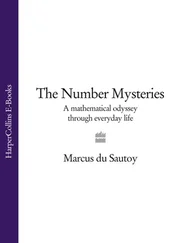Mathematicians soon realised that some of these functions, such as the one built from the equation x 2+ 1, could be fed with imaginary numbers as well as ordinary numbers. For example, input x = 2i into the function, and the output is calculated as (2i) 2+ 1 = −4 + 1 = −3. The feeding of functions with imaginary numbers had begun in Euler’s generation. As early as 1748, Euler had stumbled across strange connections between unrelated bits of mathematics by taking a trip through this looking-glass world. Euler knew that when you fed the exponential function 2 x with ordinary numbers x , you got a graph that climbed rapidly. But when he fed the function with imaginary numbers he got a rather unexpected answer. Instead of the exponentially climbing graph, he started to see undulating waves of the type we now associate with, for example, sound waves. The function that produces these undulating waves is called the sine function . The image of the sine function is a familiar repeating curve where every 360 degrees we see the same shape appearing. The sine function is now used in a host of everyday calculations. For example, it can be used to measure the height of a building from ground level by measuring angles. It was Euler’s generation who discovered that these sine waves were also the key to reproducing musical sounds. A pure note like the A produced by a tuning fork used to tune a piano can be represented by such a wave.
Euler fed imaginary numbers into the function 2 x . To his surprise, out came waves which corresponded to a particular musical note. Euler showed that the character of each note depended on the coordinates of the corresponding imaginary number. The farther north one is, the higher the pitch. The farther east, the louder the volume. Euler’s discovery was the first inkling that these imaginary numbers might open up unexpected new paths through the mathematical landscape. Following Euler, mathematicians began travelling out to this new-found land of imaginary numbers. The search for new connections would become infectious.
Riemann returned to Göttingen in 1849 in order to complete his doctoral thesis for Gauss’s consideration. That was the year in which Gauss wrote to his friend Encke of his childhood discovery of the connection between primes and logarithms. Although Gauss probably discussed his discovery with members of the faculty in Göttingen, prime numbers were not yet on Riemann’s mind. He was buzzing with the new mathematics from Paris, keen to explore the strange emerging world of functions fed with imaginary numbers.
Cauchy had begun the task of making a rigorous subject out of Euler’s first tentative steps into this new territory. Whilst the French were masters of equations and formulaic manipulation, Riemann was ready to capitalise on the German education system’s return to a more conceptual view of the world. By November 1851, his ideas had crystallised and he submitted his dissertation to the faculty in Göttingen. His ideas obviously struck a chord with Gauss. He greeted Riemann’s doctorate as evidence ‘of a creative, active, truly mathematical mind, and of a gloriously fertile originality’.
Riemann wrote to his father, keen to tell him about the progress he was making: ‘I believe I have improved my prospects with my dissertation. I hope also to learn to write more quickly and more fluently in time, especially if I mingle in society.’ But academic life in Göttingen did not at first live up to the thrills of Berlin. It was a somewhat stuffy, insular university, and Riemann lacked the confidence to engage with the old intellectual hierarchy. There were fewer students in Göttingen with whom he could relate. He was mistrustful of other people and never really at ease in a social environment. ‘He has done the strangest things here only because he believes that nobody can bear him,’ wrote his contemporary Richard Dedekind. Riemann was a hypochondriac and susceptible to bouts of depression. He hid his face behind the security of an increasingly large black beard. He was extremely anxious about his finances, surviving on the uncertainty of half a dozen voluntary students’ fees. The workload he undertook combined with the pressures of poverty led to a temporary breakdown in 1854. However, his mood would lighten whenever Dirichlet, the star of the Berlin mathematical tradition, visited Göttingen.
One professor in Göttingen with whom Riemann did manage to strike up a friendship was the eminent physicist Wilhelm Weber. Weber had collaborated on numerous projects with Gauss during their time together in Göttingen. They became a scientific Sherlock Holmes and Dr Watson, Gauss providing the theoretical underpinning which Weber then put into practice. One of their most famous inventions was to realise the potential of electromagnetism to communicate over a distance. They successfully rigged up a telegraph line between Gauss’s observatory and Weber’s laboratory over which they exchanged messages.
Although Gauss thought the invention a curiosity, Weber saw clearly what their discovery would unleash. ‘When the globe is covered with a net of railroads and telegraph wires,’ he wrote, ‘this net will render services comparable to those of the nervous system in the human body, partly as a means of transport, partly as a means for the propagation of ideas and sensations with the speed of lightning.’ The rapid spread of the telegraph, together with the later implementation of Gauss’s invention of the clock calculator in computer security, make Gauss and Weber the grandfathers of e-business and the Internet. Their collaboration is immortalised in a statue of the pair in the city of Göttingen.
One visitor to Weber in Göttingen paints a typical picture of a slightly mad inventor: ‘a curious little fellow who speaks in a shrill, unpleasant and hesitating voice. He speaks and stutters unceasingly; one has nothing to do but to listen. Sometimes he laughs for no earthly reason, and one feels sorry at not being able to join him.’ Weber had a little more of the rebel in him than his collaborator Gauss. He had been one of the ‘Göttingen Seven’ temporarily dismissed from the faculty for protesting at the arbitrary rule of the Hanoverian king in 1837. For some time after completing his thesis, Riemann worked as Weber’s assistant. During this apprenticeship Riemann developed a soft spot for Weber’s daughter, but his advances were not reciprocated.
In 1854, Riemann wrote to his father that ‘Gauss is seriously ill and the physicians fear that his death is imminent.’ Riemann was worried that Gauss might die before examining his habilitation, the degree required to become a professor at a German university. Fortunately Gauss lived long enough to hear Riemann’s ideas on geometry and its relationship to physics that had germinated during his work with Weber. Riemann was convinced that the fundamental questions of physics could all be answered using mathematics alone. The developments in physics over the ensuing years would eventually confirm his faith in mathematics. Riemann’s theory of geometry is regarded by many as one of his most significant contributions to science, and it would be one of the planks in the platform from which Einstein launched his scientific revolution at the beginning of the twentieth century.
A year later, Gauss died. Although the man had passed, his ideas were to keep mathematicians busy for generations to come. He had left behind his conjectured connection between primes and the logarithm function for the next generation to chew over. Astronomers immortalised the great man in the heavens by naming an asteroid Gaussia. And in the University of Göttingen’s anatomical collection one can even find Gauss’s brain, pickled for eternity, which was reported to be more richly convoluted than any brain previously dissected.
Читать дальше












